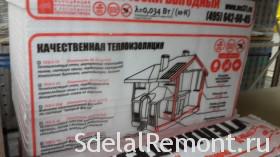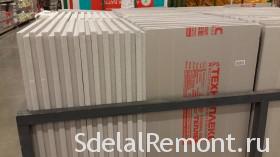 With the onset of the winter heating season begins. Here and there comes a time to think about saving. And in order that the real costs for energy sources were less, usually, you must make insulation of external or internal walls and slopes. And again the question, what material to choose, polystyrene or foam, what's better. Thermal insulation of the wires and the one and the other, it all depends on the type of premises and operational loads.
With the onset of the winter heating season begins. Here and there comes a time to think about saving. And in order that the real costs for energy sources were less, usually, you must make insulation of external or internal walls and slopes. And again the question, what material to choose, polystyrene or foam, what's better. Thermal insulation of the wires and the one and the other, it all depends on the type of premises and operational loads.
That is warmer or expanded polystyrene foam, at a glance how hard. For an accurate calculation, you can use tables thermal conductivity and other technical characteristics, such as density, thickness and flammability class.
The characteristics and properties of the foam
1. thermal conductivity 17 times less than that of bricks, namely (0,033- 0,037 W / m * K)
2. Density 12-15 kg per cubic meter (mark 15), respectively mark 30 It has 25-35 kg 1 cube.
3. The compressive strength of a single plate ranges from 0,04 to 0,05 MPa.
4. Absorption of moisture for not more than one day 1%.
5. Operating temperature range, minus 50, a plus 60 degrees centigrade.
6. Flammability foam common G2\D1 (moderately flammable, slightly flammable).
The use of such a light and rather inexpensive material is not particularly complicated manipulations. Technical buildings, Outbuildings, warehouses and technical purpose building just suitable for such material. Thermal insulation of floor slabs in the attic or walls in the country will not be too time consuming. A small price, and ease of installation is an advantage foam. Especially cutting sheets (500\600*1000 mm, 1000*1000\1200 mm, other sizes), thickness 20, 30, 40, 50, 100 mm or more is easy to find on sale.
There are several deficiencies in such material, the toxicity of combustion and due to incorrect installation of formation of mold on the walls, rather fungus. In Europe, the wall insulation is not doing a foam thickness 3-4 mm, since the material is thicker at the fire on the facade it highlights a lot of toxic gases. It is better to apply a screed on insulation of attics and other enclosed spaces.
Failure to comply with the rules of installation, Installation foam inside raw space can displace "dew point" inside, with the formation of mold is inevitable, no ventilation between the insulation.
When selecting materials for insulation, pay special attention to the density and flammability class, because the foam during combustion emits toxic gases.
The properties of polystyrene
 Such insulation sheet, as well as the foam has a uniform structure. for example, Brand Penoplex depending on the density and the class is divided into several grades: 31 (31 WITH), 35 and 45.
Such insulation sheet, as well as the foam has a uniform structure. for example, Brand Penoplex depending on the density and the class is divided into several grades: 31 (31 WITH), 35 and 45.
1. durability more 50 years old.
2. Compressive strength 0,5 MPa. To 18 000 kg 1 quarter. m.
3. Density of the extruded material is sufficiently high, than conventional granulated (foam) and is 30-200 kg per cubic.
4. Absorption of moisture to 0,4-0,5% per day.
5. One of the lowest thermal conductivity performance (0,027 W / mk)
6. Temperature mode of use -50+75 WITH.
7. Flammability G1, G2, D3, G4, NG (NG - not flammable).
Fields of application of such material varied. Thermal insulation of foundations and pavings around the house, that will prevent freezing swelling soils and foundation. Soundproof walls and ceilings. Thermal insulation of facades. In recent years, is often used to insulate the floor in front of the screed. cutting sheets, eg, from brand Penoplex width 600 mm, and the length 1200\2400 mm. Thickness 30, 40, 60, 80 and 100 mm. For qualified teams do not make much effort to insulate a house or apartment in a very short period of time. Thus saving you a lot of money for many years to come.
If we compare the foam and extruded polystyrene, it turns out, that seems to be no difference between them. Do basis odna, but the production technology and characteristics of different density. BUT the main difference between the foam of extruded polystyrene foam, This field of application. Polystyrene can be used in thermal insulation of the basement of the building. Sufficiently thick expanded polystyrene plates 20-30 mm for soundproofing partitions, and the foam need to install 50 mm.
The disadvantages of the styrofoam relates destruction upon contact with the complex hydrocarbon-type siding. Destroyed by the application of ultraviolet radiation in the clear. When heated at a temperature 25 ° C in 1 m3 material will be contained 104 styrene microgram, it's pretty much.
Of course facades with high degree of exploitation require denser material, when reinforced polystyrene foam and a second mechanical effects showed better results, Of course the choice of materials depends entirely on the performance insulate surfaces and types of buildings. For the cottage it is suitable as the best option.
How to perform insulation
The choice of insulation on a fairly large markets. A variety of proposals from the mineral wool, high density, to extruded polystyrene. What to choose? What kind of insulation technology, brand adhesive and mesh for reinforcement of purchase? There are many questions, and the answer is. What exactly is required to insulate? Take, example, facade. Installation polystyrene plates suitable for this best.
On the consumption of mineral wool blend for the shelter will be on 15 % more than styrofoam. Since the first base layer is deposited on a relatively uneven surface, and trim wool electric planers impossible, unlike styrofoam slab. On the plate polystyrene extrusion and turn our attention to you. We decompose the entire process on the shelves.
properties plates, specification
- Density Compressive at 10% linear strain, no less 0,25 MPa.
- Static bending strength 0,4-0,7 MPa.
- The absorption of water per day 0,1% by volume.
- Resistance to fire (flammability class) D 1, AT 2, D 3, Polish 1.
- Thermal conductivity at +25 C W \ (MS)- 0,028.
- The ability to pass steam Mg \(m h Pa) 0,018.
- mode of operation -50+75 oC.
Some manufacturers Epps
Manufacturers Brands Technonikol, URSA, Primaplex, Penoplex, IZOBOX, Polispen produce modified extrusion plate pretty good quality. Use for heat and sound insulation slabs, roofs and basements suitable plate with a higher strength grade SPB-C 35, 45. less brand 30 well established itself in the device "warm floor".
The size of such material manufacturers about the same markets, 600 mm 1200 mm and longer. There are plates, and other sizes in the brand Technonikol, CARBON ECO SP 2360*580*100 mm. Punched and without, with locks and without them. choice is great.
What should be done to improve the adhesion and interaction with glue
1.Shkurit plate sandpaper across the plane, generally, cause scratches for improved adhesion adhesive.
2. Remove dust and residues solutions with walls and slopes.
3. Prime the surface, deep penetration primer for facade work.
4. Gaugeable plumb walls, uneven portions align with a plaster or adhesive.
5. Track temperature for the entire period of installation, less mode 8 degrees Celsius will not allow, as well as above 30 and not desirable.
Chose the polystyrene sheet thickness 50 mm, should be considered, that an overlap at the corners will be over 50 mm considering the thickness of the adhesive. It should therefore be adjusted to produce markings on the adhesive thickness, and an overlap. And it is better to choose the material with locks for easy installation and construction of the fortress.
Adhesive for insulation boards choose stands on several key criteria. Elasticity after drying, the presence of microfibers, Operating temperature (frost-resistance, insulating characteristics) and high quality adhesion to extrusion polystyrene foam slabs.
Council; Apply the adhesive evenly over the entire plane of the plate, and has no place in the form of small dimes.
installation of plates, Other installation types
Plates with locks is better to start to mount on both sides of the corners, and the apparatus facilitates angle measurements. Care should be taken and for the "Extension" seams, angles of the first row of tiles need not coincide with the corners of the next row of plates. And so to the top of the wall or corner. A plant or fungus umbrellas (dowels suckers), It must comply with technology, namely 7 PC. on the corners 8-9.
When installing insulation boards caps can be produced on bitumen, the melting point of polystyrene allows to make such works quickly, plus bitumen serve as waterproofing and adhesive, and will not allow moisture to penetrate through the bottom, "Dew point" will go out. The thermal insulation of residential, loft mount 100 mm material, vapor barrier between two membranes. Instead of glue, you can use assembly foam, an example of how to do it.
Important: ingress of glue at the seams between the plates, unacceptable!
After installation of the plates can proceed to the next phase of work, reinforcement mesh and application of decorative facade finishing layer. design, which will please you for years to come.
Video on what to choose foam or Styrofoam












